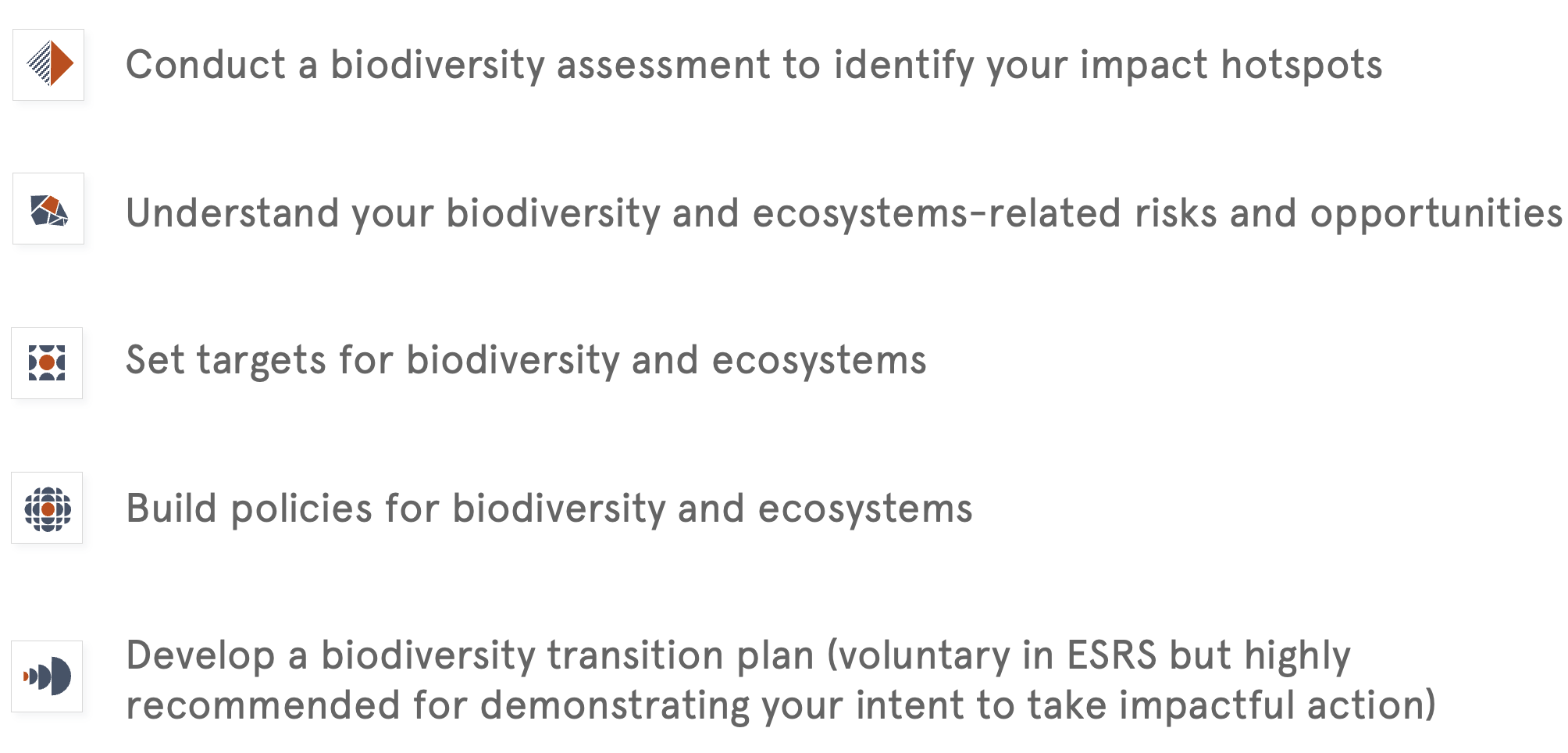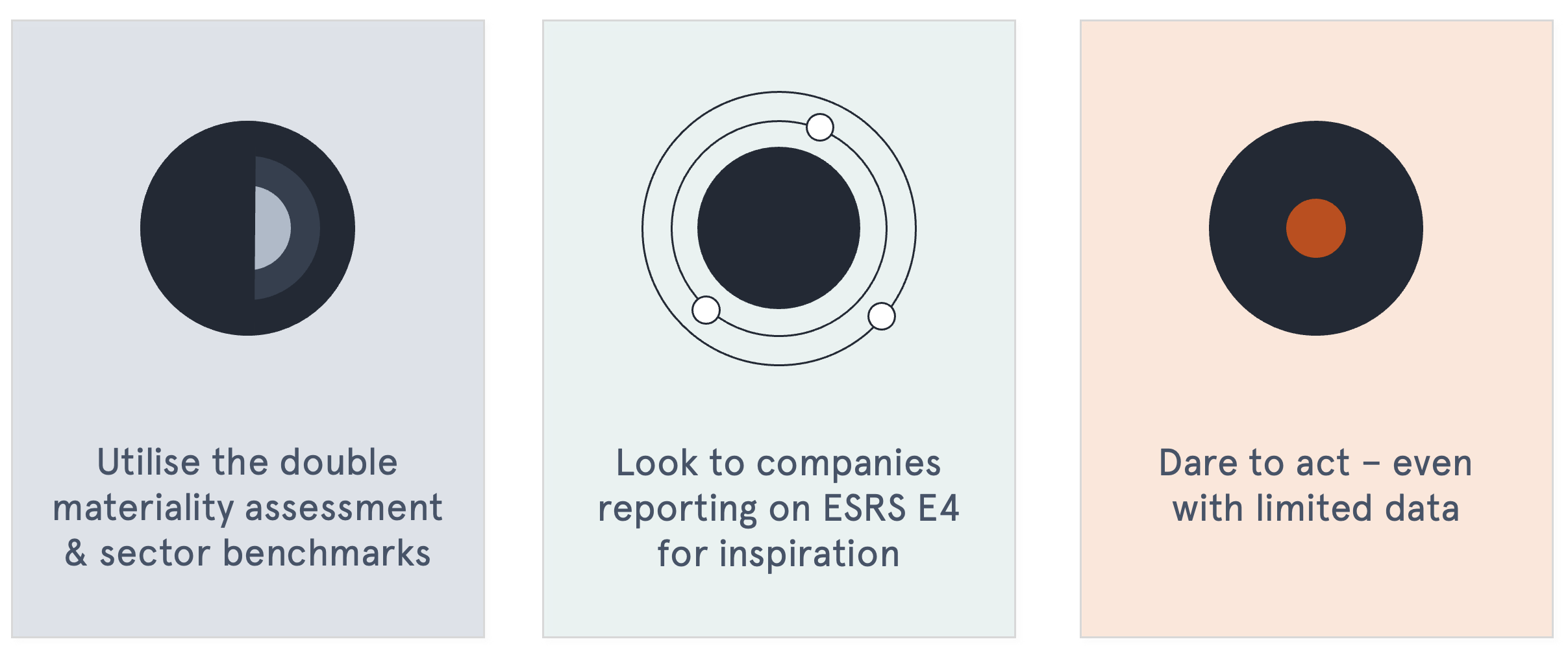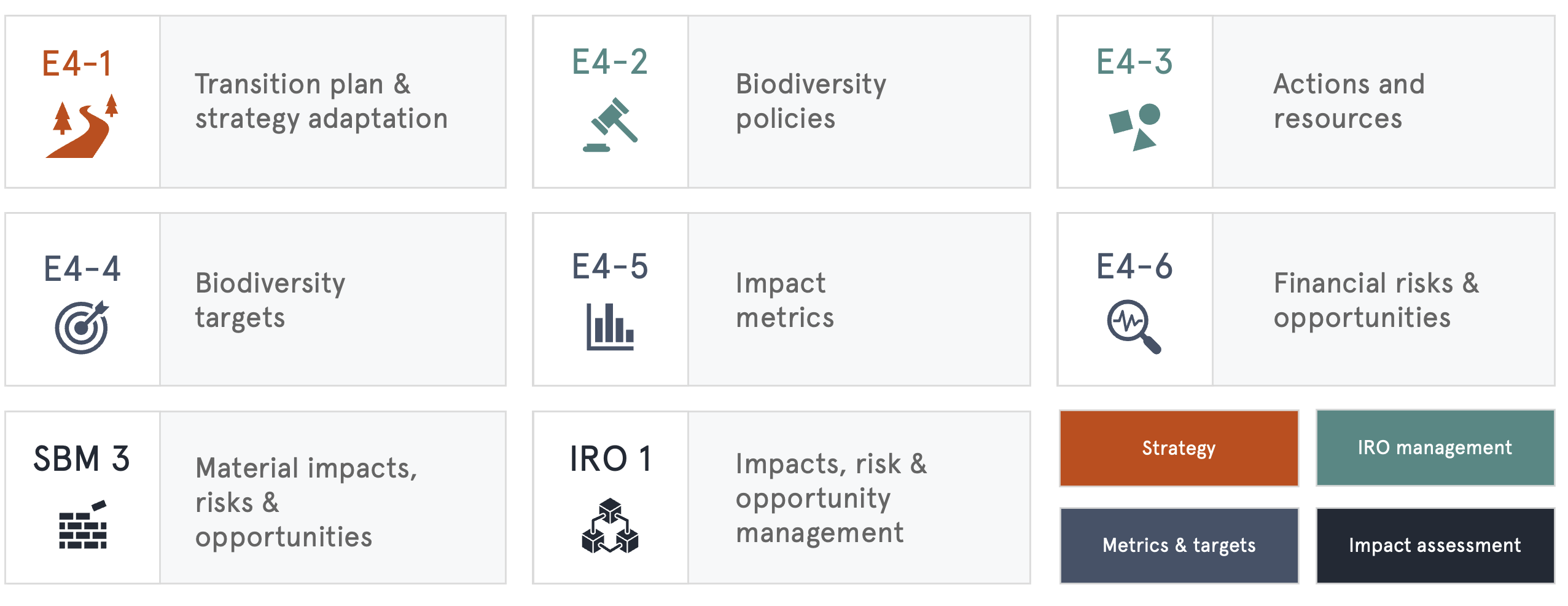
Global biodiversity loss is accelerating, with serious consequences for people, the planet, and the economy. Wildlife populations have declined by 73% in the past 50 years1, and up to 55% of global GDP2 relies moderately to heavily on nature. For businesses, this means that ecosystem degradation poses significant risks to supply chains, raw material availability, and overall market stability. Understanding your company’s impact on nature is pivotal for identifying and mitigating these risks.
>In this article, we explore the strategic value of biodiversity action, offer practical recommendations on assessing nature-related impacts, and highlight the best frameworks for biodiversity assessments. We also examine how biodiversity disclosures under CSRD’s ESRS E4 reporting standard can guide your company in integrating nature into its sustainability strategy.
What is biodiversity?
Let’s start with a short definition of biodiversity to help us navigate its crucial role. Biodiversity represents the vast variety of life on our planet, including bacteria, fungi, plants, as well as insects and animals. All these actors work together in intricate ecosystems to provide us with everything we are so dependent on, such as food, clean water, medicine and shelter. Learn more in our in-depth article on biodiversity here →

Why biodiversity could be your organisation’s best investment yet
Embracing biodiversity is about seizing opportunities, and as such, companies taking decisive action on biodiversity stand to gain in multiple ways:
- Long-term stability and climate resilience
- Regulatory compliance and competitive advantage
- Access to capital
- Enhanced brand reputation and consumer trust
- Talent attraction and employee retention
Strategically integrating biodiversity in 5 steps
If your business is ready to take meaningful action on biodiversity, following a clear strategy is key. Here are a few practical ways to get started on the right track:

These steps lay a solid foundation for working strategically with biodiversity. They also align with the disclosure requirements laid out in the ESRS standard E4 and support companies in their CSRD implementation.
Frameworks for evaluating your biodiversity impacts
We recommend consulting these best-practice frameworks for biodiversity assessments:
- ENCORE: Location-based and sector-based biodiversity impacts, risks and dependencies. This framework poses a great starting point for working with biodiversity.
- WWF Biodiversity Risk Filter: A free screening tool for location-based risk assessment.
- IBAT (Integrated Biodiversity Assessment Tool): This tool is similar to the WWF Risk Filter but much more costly.
- TNFD: A voluntary framework for assessing and disclosing impacts, financial risks and dependencies. It is highly aligned with the ESRS and recommended for use, especially if your company is in the financial sector.
Taking action: 3 practical recommendations
Here are our suggestions for how to get started on addressing your biodiversity impact:

- Utilise the Double Materiality assessment and sector benchmarks
Companies are often aware of the most critical areas to address from their double materiality assessments or sector benchmarks like ENCORE or The Global Reporting Initiative (GRI). If you are unsure about the main biodiversity hotspots in your value chain, we recommend using tools like ENCORE or consulting SBTN’s High Impact commodity list (HICL).
- Look to companies reporting on ESRS E4 for inspiration
As the first CSRD reports are published in the coming weeks, observe how companies are approaching this topic. While these examples can offer valuable insights, ensure your organisation’s actions align with its own specific impacts and dependencies. Following others too closely without adaptation could lead to misallocated resources and missed priorities.
- Dare to act – even with limited data
For many companies, the main impacts are located in their upstream value chain, where limited data availability is often an issue. However, acting on what you know can be impactful, even if you lack the full picture. Don’t let the pursuit of (perfect) data be an obstacle—act on your available data and on assumed material areas while simultaneously improving data collection and quality.
CSRD marks a new era for corporate biodiversity responsibility
The Corporate Sustainability Reporting Directive (CSRD) has thrust biodiversity into the corporate spotlight. The CSRD and its underlying European Sustainability Reporting Standards (ESRS) mandate thousands of companies to address their impacts on a wide range of sustainability-related issues.
The ESRS standard E4 focuses on biodiversity. It outlines specific business activities that companies must report on if these activities are considered material to them.
Businesses in the first wave of CSRD reporting will begin releasing their first reports in the coming weeks. These reports can be expected to inspire others and spark conversations about how companies should grapple with the topic of biodiversity.
ESRS E4 overview
The reporting standard for biodiversity and ecosystems (ESRS E4) covers 8 disclosure requirements:
These requirements are embedded in different building blocks of the standard, including a) strategic elements, (b) management of biodiversity-related impacts, risks and opportunities (IROs), and (c) metrics and targets for biodiversity and ecosystems.

>>>>>As part of the ESRS E4 standard, companies are encouraged to develop a transition plan for biodiversity, in which they explain how they will adjust their business model and strategy to mitigate negative biodiversity impacts. This is voluntary, but highly recommended for demonstrating intent of impactful action.

>>>>>ESRS E4 mandates companies to describe their processes for identifying and assessing material biodiversity and ecosystem-related impact, risks and opportunities (IROs). To gain a more in-depth understanding of dependencies and impacts on nature, companies may conduct the assessment in line with the TNFD LEAP approach. This can, in particular, offer support with locating the company’s interface with sensitive areas.
Biodiversity and ecosystem policies should be included and aligned with the rationale behind the targets. Additionally, the planned actions and allocated resources for biodiversity and ecosystems must be detailed.

Companies must also report their targets related to biodiversity and ecosystems. With Science-Based Targets not having biodiversity targets yet*, and in lieu of a universal metric for biodiversity like CO2e, companies should consider their value chain when setting biodiversity goals. For some, deforestation might be the most pressing issue driven by their activities, while for others, targets on the elimination of harmful chemicals or rewilding of specific hectares might be the most relevant biodiversity impact to address.
Impact metrics used for the biodiversity assessment should also be reported under E4. Deciding which metrics to report on is fully dependent on what a company finds material, as the majority of E4 metrics are voluntary. For example, if a company decides to reduce the amount of soil-sealed (in other words, paved) areas in its operations, material metrics could be total land in operations and how much of that is sealed.
Organisations should disclose the anticipated financial effects of biodiversity and ecosystem-related risks and opportunities. This is, for example, the case if a company relies on raw materials that are forecasted to be increasingly scarce due to, e.g. loss of pollinators, climate change or losses in soil fertility.
Charting the road ahead requires integrating biodiversity into your business strategy
The business imperative for biodiversity action has never been more critical. Companies must conduct comprehensive biodiversity assessments, develop robust strategies aligned with global frameworks, and take decisive action to mitigate risks while unlocking opportunities for innovation and sustainable growth.
>By embracing biodiversity as a core strategy, organisations can secure their long-term resilience and contribute to preserving our planet’s natural capital.
If you have more questions about biodiversity and double materiality assessments, reach out to our biodiversity expert: David Færgeman.
*As of February 2025, SBTN has released methods for setting science-based targets for nature, focusing on freshwater and land. Companies are encouraged to explore SBTN’s target-setting guide and corporate manual to inform their biodiversity strategies.
Read more
- 1WWF (2024), Living planet report
- 2PwC (2023), Managing nature risks: From understanding to action
- A step-by-step guide to ESRS Double Materiality Assessments
- Implementing the CSRD

The business case for biodiversity: A place to begin
Discover how nature-positive practices can create lasting value





